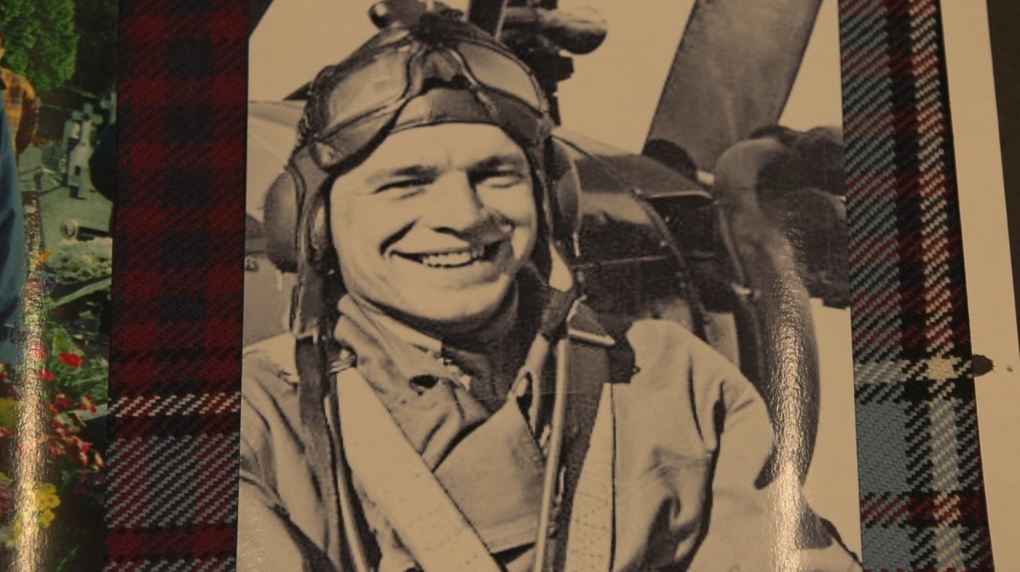'It's pretty spectacular': B.C. man honoured 80 years after uncle's plane shot down in Belgium
 For a civilian, it was an extremely rare occurrence. Jay Hammond has never flown a plane, but on Friday he received a pair of pilot wings at a ceremony in North Saanich.
For a civilian, it was an extremely rare occurrence. Jay Hammond has never flown a plane, but on Friday he received a pair of pilot wings at a ceremony in North Saanich.
For a civilian, it was an extremely rare occurrence. Jay Hammond has never flown a plane, but on Friday he received a pair of pilot wings at a ceremony in North Saanich.
Lt. Col. Matt Dukowski of 443 Maritime Helicopter Squadron described presenting the wings to Hammond as "an honour."
The reason Dukowski was honoured to present a the military decoration – which is normally given to pilots when they become qualified to fly – has to do with Hammond's uncle Wilbur Bentz, who was a pilot during the Second World War.
On May 13, 1944, Bentz's Halifax Bomber was shot down over Belgium by the German Luftwaffe, killing all on board.
Hammond even knows the approximate time the plane went down.
"Three to four o'clock on May 13th 1944,” he said. "My mother used to keep a picture of Wilbur on her night stand."
It was a loss the family never got over.
In 1984, Hammond’s mother died. That’s when he began reading letters that Bentz had sent to family and friends during the war.
"I got really interested to find out what actually happened,” said Hammond.
Through his digging, he found the names of the entire flight crew and discovered that the bomber had been downed in a marshy bog in Belgium.
 Jay Hammond's uncle Wilbur Bentz was a pilot during the Second World War.
Jay Hammond's uncle Wilbur Bentz was a pilot during the Second World War.
In 1997, after years of research, Hammond and his sister Maureen Thom travelled to that bog with a number of volunteers. The team began digging with an excavator, and soon the machine hit metal.
"We knew we had found something,” said Hammond.
It turned out to be the Halifax Bomber. Inside, human remains were found, including those of Bentz, along with everything else that was onboard when the bomber went down.
"We found a watch that showed the time of impact,” said Hammond.
Over time, the plane and its contents were removed and the aluminum was melted down in ingots. Those ingots are now used in the production of every pilot's wings since 2021. That has become a huge honour for Bentz’s relatives.
"Every member of the Royal Canadian Air Force who has been awarded these wings remembers my uncle,” said Hammond.
In a final twist in this story, through his research, Hammond was able to find the man – Martin Drewes – who shot down Bentz’s bomber that May morning in 1944.
When the family laid Bentz’s remains to rest, Drewes appeared at the funeral.
"I couldn't find that anger because I realized he was doing his job and it could have just as easily been Wilbur that shot down the Messerschmitt,” said Thom.
Drewes has since died, but before that happened, both Hammond and Thom became close with the man.
The family is now at peace with Bentz's death, knowing his legacy will live on for years to come through the pilot wings.
“It's pretty spectacular,” said Hammond.
CTVNews.ca Top Stories

B.C. carjacking suspect sped across U.S. border before arrest, police say
Authorities have arrested a suspect who allegedly carjacked a pickup truck in B.C.'s Lower Mainland then sped across the U.S. border, triggering a massive police response.
Alberta premier says federal border plan coming Monday
The much-anticipated federal plan to address issues at the Canada-U.S. border will be unveiled on Monday according to Alberta Premier Danielle Smith.
Ottawa has sold its stake in Air Canada: sources
Two senior federal government sources have confirmed to CTV News that the federal government has sold its stake in Air Canada. During the COVID-19 pandemic in 2021, the government purchased a six per cent stake in the airline for $500 million as part of a bailout package.
Premiers disagree on whether Canada should cut off energy supply to U.S. if Trump moves ahead with tariffs
Some of Canada's premiers appeared to disagree with Ontario Premier Doug Ford on his approach to retaliatory measures, less than a day after he threatened to cut off the province's energy supply to the U.S. if president-elect Donald Trump follows through on his threat of punishing tariffs.
'Very concerned': Crews search B.C. ski resort for missing man
Police and rescue crews are searching for a man who was last seen boarding a ski lift at B.C.'s Sun Peaks Resort Tuesday.
Man who set fires inside Calgary's municipal building lost testicle during arrest: ASIRT
Two Calgary police officers have been cleared of any wrongdoing in an incident that saw a suspect lose a testicle after being shot with an anti-riot weapon.
Blizzard warning shuts down large parts of midwestern Ontario
It was a day to stay home, if you could, across much of midwestern Ontario due to weather.
Travis Vader, killer of Lyle and Marie McCann, denied day parole
The man who killed an Alberta couple in 2010 has been denied day parole.
She took a DNA test for fun. Police used it to charge her grandmother with murder in a cold case
According to court documents, detectives reopened the cold case in 2017 and then worked with a forensics company to extract DNA from Baby Garnet's partial femur, before sending the results to Identifinders International.
































